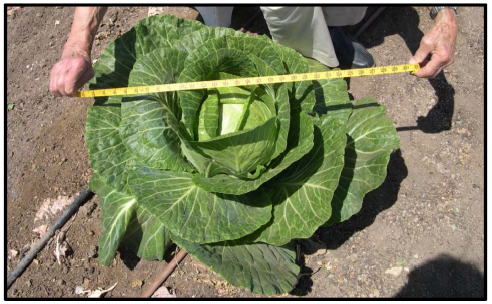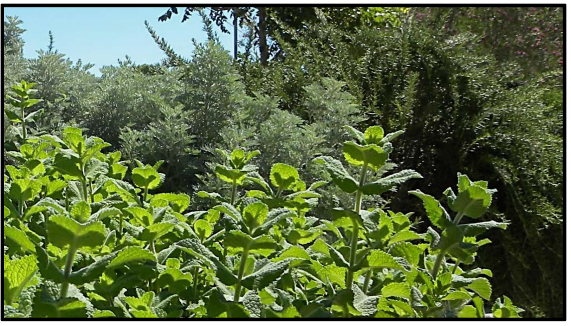Introduction
Vegetable Gardening in the Moapa and Virgin Valleys (University of Nevada Cooperative Extension Special Publication 09-01) authored by Sylvan Wittwer is requested on a regular basis and is considered the essential vegetable-growing manual for the area. Excerpts from that publication and input from other longtime local growers have been used as the basis for this publication. The purpose of this publication is to emphasize the selected vegetable varieties or cultivars (seeds/plants) that may perform better than others in the Moapa and Virgin Valleys.
The climate here is comparable to that of Egypt along the Nile River Valley. In both areas there are three major growing seasons: fall, winter and spring. Rainfall averages about 4 inches per year. Precipitation is both unpredictable and localized. Average daytime temperatures during July and August usually peak above 100 F, with readings often 110 F to 120 F during early afternoon, and 65 F to 95 F at nighttime. The differences between day and night temperatures at ground level may be as much as 50 F. The soil is alkaline with a high salt content.
Use the climatic conditions to your best advantage. Take advantage of the climatic resources of the Moapa and Virgin Valleys by the use of site selection. Extend the spring season by using transplants, row and plant covers, and wise selection of varieties. Take advantage of the sun with row orientation and provide protection by using shade covers. Take advantage of fall and winter production for cool-season crops to avoid weeds, reduce water requirements, improve produce quality and enjoy working in cooler temperatures.
Seed companies may not stock varieties of some vegetables well adapted for the valleys. Gardeners are encouraged to trade with their neighbors who have successfully grown an outstanding variety. The local Cooperative Extension office can provide information on how to save and collect seeds from older open-pollinated cultivars. While only selected vegetables that have proven particularly successful are included in this publication, readers are encouraged to experiment with other cultivated vegetable varieties that may be of interest.
Asparagus
A significant harvest can be achieved if vigorous, all-male, one- or two-year-old hybrid roots are used. All-male hybrids produce only male plants that do not develop seed. Since no seed is produced, the energy that would normally go into seed production is available for the crowns and roots making a larger more vigorous plant.
- Purple Passion – Purple Passion is a delight to eat. The sugar content of the spear is 20 percent higher than green asparagus, which makes for a very mild, sweet tasting spear.
- Jersey King – This variety is widely adapted, strong consistent yields.
- Jersey Knight – This variety is widely adapted, produces a large green spear with purple bracts and is considered to be excellent quality. It is a good variety for replanting asparagus beds because of its disease resistance.

A large cabbage measuring about 29 inches across.
Cabbage
Cabbage is a cool-season vegetable suited to early spring, fall and winter seasons. The key to growing great cabbage is steady, uninterrupted growth. Set out spring cabbage transplants early enough so that they can mature before the heat of summer. For a longer cabbage harvest plant two or three varieties with different maturities.
- All Season – Also known as Vandegaw and Succession, this variety is heat resistant, fine flavored and produces good, hard heads that are 10 inches in diameter, average about twelve pounds in weight, and are round but flattened on the top. A large cabbage measuring about 29 inches across.
- Early Jersey Wakefield – This cabbage forms a compact, somewhat conical head with glaucous-green leaves. It is a wonderful early heading variety that occupies little garden space.
- Mammoth Red Rock – Also known as Red Danish, it is well adapted for most growing conditions and yields large (4 to 7 pound), red, solid, round heads that have fine flavor and keep well. This variety is great raw, cooked or pickled, and has a nice deep color.
Greens
These include spinach, Chard, Kale, Collards, etc. and are all planted at the same time, with similar requirements, and fulfill a similar dietary role. Diversifying the planting increases variety and nutrition, and provides a more reliable and constant supply of fresh greens, as some will mature sooner than others, bear longer, or be more resistant to pests, inclement weather, etc.
Spinach
There are two main types of spinach - the savoyed, with crinkled or crumpled leaves, and the smooth. Both have excellent quality, are about equally productive and have equivalent harvest times and nutritional value.
- Long Standing Bloomsdale – A typical example of traditional savoy leaf spinach. This heirloom treasure introduced in 1826 has a sweet, rich flavor and good texture that have assured its popularity. It has tender, large, thick, crinkled, deep-green leaves on upright stems and is slow to bolt.
- Olympia Hybrid – This is an excellent smooth-leafed variety with leaves that are easy to wash. Smooth-leaved hybrid varieties are gaining in popularity, especially in restaurants and salad bars.
Chard
Chard is a leafy green vegetable with stalks that often vary in color. It has been bred to have highly nutritious leaves at the expense of the root. A long-season vegetable, chard will supply tasty greens through fall and winter frosts.Chard: Chard is a leafy green vegetable with stalks that often vary in color. It has been bred to have highly nutritious leaves at the expense of the root. A long-season vegetable, chard will supply tasty greens through fall and winter frosts.
- Bright Lights – Light up garden and patio containers with the dazzling colors of this edible leaf that doubles as an ornamental. Stem colors include gold, orange, pink, yellow, crimson and lavender! Bright Lights tolerates some shade and won’t get bitter in hot weather.
- Fordhook Giant Chard – Succulent celery-like stalks support large, dark-green, very savoyed, fleshy leaves. The delicate, pale-green 8- to 10- inch stalks are wonderfully tender and juicy.
Kale
Kale is one of the most frost-tolerant vegetables. It excels in cold weather, tasting best after frost has kissed the tender, succulent leaves, and making moderate growth whenever there is even a slight warm spell.
Collards
The name "collard" is an altered form of the word "colewort" (cabbage plant). The plant is very similar to kale.
- Georgia Southern Collard – This non-heading type of collard is slow to bolt and grows 2 to 3 feet. Leaves are tasty, tender, mild and juicy. Georgia Southern tolerates heat and poor/sandy soils.
- Morris Heading Collards – This popular heirloom is fast growing and produces loose heads that are dark green and slow bolting. Its tender leaves are very delicious.

Egyptian mint, wormwood and rosemary growing in an herb bed.
Herbs
Culinary herbs are used in small amounts and provide flavor, rather than substance, to food. Many culinary herbs are perennials, such as thyme and oregano, while others are biennials, such as parsley and cilantro, and some are annuals, including basil and fennel.
Arugula – This perennial has long, dark, lobed leaves that are suitable for salad mix or sandwiches. White flowers with dark-pink veins make attractive, spicy additions to salad mixes.
Basil – Basil is considered the premiere culinary herb, with a marvelous variety of flavors from which to choose. The bushy basil plants, especially the purple-leaved types, also look great in the flower garden.
- Cinnamon Basil – This variety has purple-red stalks, pinkish flowers, and glossy dark-green leaves. Its sweet spicy flavor is great when matched with fruit.
- Genovese – This famous Italian heirloom is very popular with many cooks.
- Lemon Basil – With an intense citrus aroma, it is popular for vinegars and seafood dishes.
Chervil – Best when used fresh, chervil can also preserved in vinegar or olive oil, which can be frozen. It's good for flavoring cheese and eggs and is good used with tarragon.
Chives – Chives have a mild onion flavor, perfect for salads, vegetables, egg dishes and soups.
Cilantro – Popular in Mexican cuisine, this herb is a must for all salsa and chili recipes, delicious and flavorful.
Dill – This winter crop is easy to grow, early to flower, and has large seed heads that will reseed for next winter. It is excellent in pickles and used to flavor many other foods.
Fennel – This tasty herb grows like dill and is used in Italian cooking.
Green Onions – Scallion plants grow easily from seed and are a hardy addition to any garden.
Marjoram – This fragrant and flavorful perennial herb is a popular seasoning.
Oregano – Oregano is a must for any culinary herb garden. Plant this beloved perennial herb in any spot, and enjoy its robust flavor for years to come.
Parsley – One of the most nutritious herbs, it has flavorful leaves and roots for garnish and cooking. Use fresh or dried in a variety of dishes. Parsley is an annual winter crop that is easy to grow in the garden or in a pot, indoors or outdoors.
- Curled – This standard parsley is a fast grower in the fall, winter and early spring. Plant Curled Parsley seeds in either full sun or partial shade.
- Italian – This flat leafed variety has a more subtle flavor and aroma than regular parsley.
Rosemary – This highly fragrant perennial is used for cooking and potpourri.
- Arp – Regarded as the hardiest rosemary cultivar it has edible blue flowers and a faint lemony scent.
- Blue Spire – This good culinary variety has bright blue blooms on upright stems and very fragrant, rich green foliage.
- Tuscan Blue – This tall variety with broad leaves is great for potpourri and for seasoning white meats, vegetables and soups.ds in either full sun or partial shade.
- Italian – This flat leafed variety has a more subtle flavor and aroma than regular parsley.
Sage – Classic culinary sage is an excellent perennial herb for flavoring meat, cheese, and bean dishes.
- Extrakata – Extrakata has a higher essential oil content (1.5-2%) and is higher yielding than common sage. Use fresh or dried to flavor chicken, sauces and dressings.
- Green Culinary – This classic culinary herb is an attractive grey-green shrubby plant with beautiful mauve flowers.
Thyme – One of the most versatile herbs used in cooking, this perennial can be used to season any meat or vegetable. It is good in salads, soups, chowders, sauces, breads, and even jellies and desserts.
- Creeping Thyme – This ground cover plant is an evergreen requiring very little maintenance
- Lemon Thyme – Having a slightly more-pronounced lemony fragrance, this herb pairs particularly well with fish.
Lettuce
Lettuce is a fairly hardy, cool-weather vegetable that is best planted in early fall, because at high temperatures, growth is stunted, the leaves may become bitter and the seedstalk forms and elongates rapidly. However, some types and varieties of lettuce withstand heat better than others.
- Jericho – This romaine variety is heat tolerant for early summer harvests. It has bright green leaves, unique silky texture and sweet flavor even in the heat of the summer. Jericho has some tolerance to Powdery Mildew and Downy Mildew as well as excellent resistance to heat stress and Tip Burn.
- Nevada – This variety is a green leaf that forms large, open heads. Its vibrant green leaves are glossy, thick, and beautifully ruffled with a satisfying combination of crunchy texture and buttery smoothness. It has excellent bolt resistance while still maintaining good texture and flavor in the hot summer sun.
- Lovelock – A heat tolerant, heading lettuce with whorls of bright green leaves with deep red coloring on the leaf margins. Heads close in late at maturity creating a dense crisp head.
- Winter Density – This variety has a crisp sweet succulent dark-green, very uniform, medium-sized head lettuce with rounded, smooth, romaine-like leaves. Very good sweet and robust flavor. Great for autumn planting, will hold up in the coldest months, but it tends to bolt in summers.
- North Pole – This is a Bibb type lettuce with buttery light-green heads. Extremely hardy and is a good winter lettuce, but not for summer.
- Rouge d'Hiver – This variety is a French heirloom from the 1800s that is commonly used as baby leaf lettuce. However, Rouge d'Hiver forms an amazing head lettuce as well. Its sweet, broad, flat, crisp leaves range from crimson red to bronze to emerald green. Heat and cold tolerant it excels as an early spring, fall or winter planting. Disease resistance to tip burn and lettuce drop.
Summary
We have concentrated on varieties of certain vegetable types; listed below are some considerations before choosing which vegetables to plant.
- Asparagus is very productive in the arid, hot climate of the Moapa and Virgin Valleys.
- Cabbage performs very well in bright sunny areas of the Moapa and Virgin Valleys.
- Greens are the ideal crop for winter production in the Moapa and Virgin Valleys. They should be a part of everyone’s winter garden.
- Herbs are hardy to the hot summers and cold winters of the Moapa and Virgin Valleys.
- Lettuce is the ideal crop for winter production in the Moapa and Virgin Valleys. There is a large variety from which to choose.
References
Climate information from Desert Research Institute for Community Environmental Monitoring Program station at Overton, Nevada available at: CEMP.
Sunset Western Garden Book. Seventh Edition; Sunset Publishing Corporation, Menlo Park, CA.
O’Callaghan, Angela. (2002). Home Vegetable Production in Southern Nevada. University of Nevada Cooperative Extension Fact Sheet 02-61.
Wittwer, Sylvan, Alice Crites and Pamela Proctor. (2004) Vegetable Gardening in Moapa and Virgin Valleys. University of Nevada Cooperative Extension Special Publication 09-01.

Maurine and Sylvan Wittwer Sylvan Harold Wittwer, 95, passed away on Jan. 20, 2012.
Bishop, C. and Stoesser, D.
2013,
Leaf Vegetable Varieties for the Moapa and Virgin Valleys,
Extension | University of Nevada, Reno, FS-13-06


